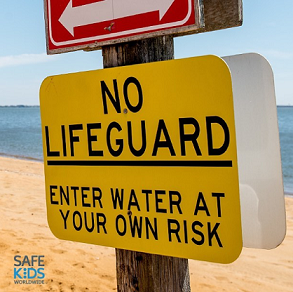Community
커뮤니티
2018-05-29 18:29:29
Safe Kids Worldwide News
KEEPING KIDS SAFE IN OPEN WATER
What Families Can Do To Keep Kids Safe!
➀Watch kids when they are in or around water, without being distracted. Keep young children and inexperienced swimmers within arm’s reach of an adult. Make sure older children swim with a partner every time.
➁Make sure children learn how to swim. Every child is different, so enroll children in swim lessons when they are ready. Consider their age, development and how often they are around water when deciding if they are ready.
➂Make sure kids learn these five water survival skills and are able to:
-step or jump into water over their head and return to the surface;
-turn around and orient to safety
-float or tread water
-combine breathing with forward movement in the water
-exit the water.
➃Teach children that swimming in open water is different from swimming in a pool. Be aware of situations that are unique to open water, such as limited visibility, depth, uneven surfaces, currents and undertow. These potential hazards can make swimming in open water more challenging than swimming in a pool.
➄Use designated swimming areas and recreational areas whenever possible. Professionals have assessed the area, and there are usually signs posted regarding hazards and lifeguard schedules.

자연 물놀이 장소에서 아이들을 안전하게 지켜주세요.
아이의 안전을 지키기 위해 가족들이 해야할 것!
➀ 아이가 물속이나 물 주변에 있을 때는 늘 조심하세요. 어린 아이 혹은 수영에 미숙한 사람은 어른의 손이 닿는 곳에 있어야 합니다. 아이들이 파트너와 함께 수영할 수 있게 하세요.
➁ 수영하는 법을 배우세요. 모든 아이들은 다르기 때문에 아이가 준비가 되면 수영 수업에 등록시키세요. 준비되었는 가를 결정할 때는, 나이와 발육상태 그리고 물에 노출되는 빈도를 고려하세요.
➂ 다음의 5가지 생존 기술은 익히게 해주세요.
-깊은 물 속에 점프했다가 다시 물 표면으로 올라오기
-돌아서서 안전한 방향으로 헤엄치기
-물속에서 뜨기와 선헤엄치기
-앞으로 나아가면서 물 속에서 호흡하기
-물에서 빠져 나오기
④ 자연 속에서의 수영은 수영장에서의 수영과는 다르다는 것을 가르치세요. 제한된 시야와 물의 깊이, 고르지 않은 표면, 물의 흐름과 저류 등 고유한 특성을 설명해주고, 그래서 자연에서의 수영은 훨씬 위험하다는 것을 알려주세요.
➄가능한 한 지정된 수영 장소와 놀이 장소를 가세요. 그곳은 주로 경고 사인과 구조원 등이 있는 곳을 의미합니다.
기사모음
총 336건이 있습니다.
| 번호 | 제목 |
|---|---|
| 336 |
<4월 안전정보> 장난감 안전사고   2024-04-25
2024-04-25
|
| 335 |
DRIVEWAY SAFETY  2024-03-22
2024-03-22
|
| 334 |
<3월 안전정보> 어린이 교통사고  2024-03-19
2024-03-19
|
| 333 |
MEDICATION SAFETY FOR BABIES  2024-02-27
2024-02-27
|
| 332 |
<2월 안전사고> 학교주변 안전사고  2024-02-27
2024-02-27
|
| 331 |
FIRE SAFETY  2024-01-30
2024-01-30
|
| 330 |
<1월 안전사고> 가정내 안전사고  2024-01-30
2024-01-30
|
| 329 |
SAFETY TIPS FOR ALL YOUR HOLIDAY ADVENTURES  2023-12-19
2023-12-19
|
| 328 |
<12월 안전사고> 주방내 안전사고  2023-12-19
2023-12-19
|
| 327 |
<10월 안전사고> 생활공간 안전사고  2023-10-26
2023-10-26
|
| 326 |
MAKE HALLOWEEN FUN AND SAFE WITH THESE TIPS  2023-10-26
2023-10-26
|
| 325 |
<9월 안전사고> 차량운행 안전사고  2023-09-27
2023-09-27
|
| 324 |
CAR SEAT SAFETY TIPS  2023-09-26
2023-09-26
|
| 323 |
BABY  2023-08-30
2023-08-30
|
| 322 |
<8월 안전정보> 영아 안전사고  2023-08-25
2023-08-25
|
| 321 |
<7월 안전정보>익수사고  2023-07-25
2023-07-25
|
| 320 |
6 GRILLING TIPS TO KEEP YOUR KIDS SAFE  2023-07-25
2023-07-25
|
| 319 |
<6월 안전정보> 폭죽사고  2023-06-28
2023-06-28
|
| 318 |
HAVE FUN ON THE FOURTH - LEAVE FIREWORKS TO THE PROFESSIONALS  2023-06-28
2023-06-28
|
| 317 |
GETTING READY TO DRIVE  2023-05-30
2023-05-30
|
